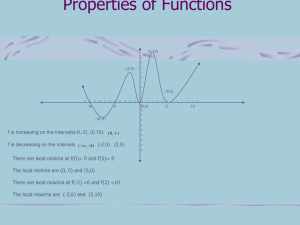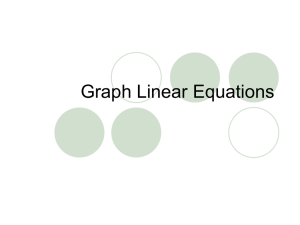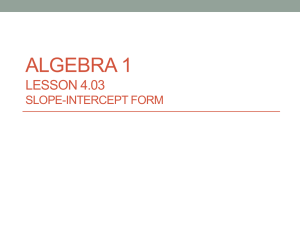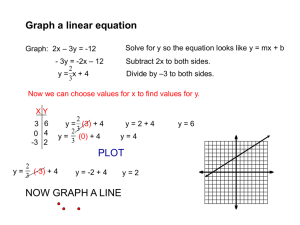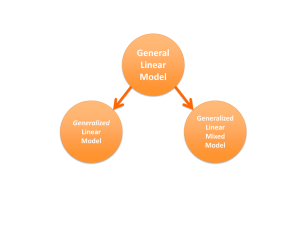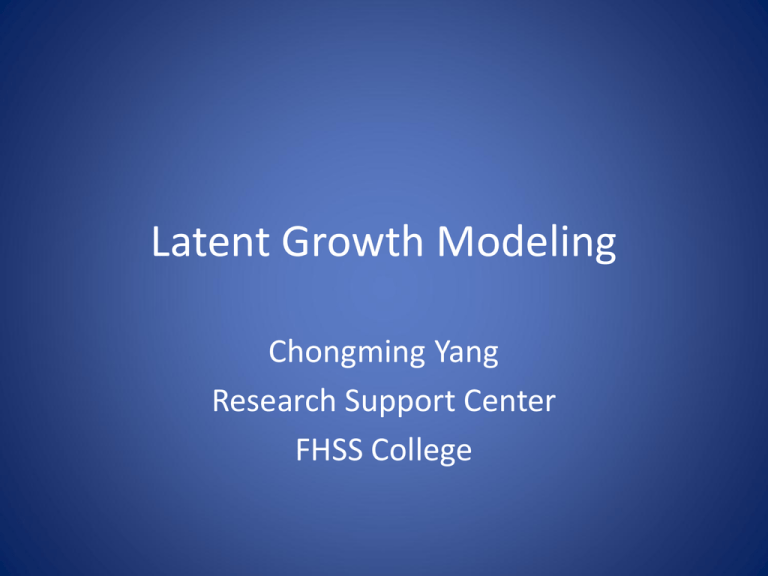
Latent Growth Modeling
Chongming Yang
Research Support Center
FHSS College
Objectives
• Understand the basics of LGM
• Learn about some applications
• Obtain some hands-on experience
Limitations of Traditional Repeated
ANOVA / MANOVA / GLM
•
•
•
•
Concern group-mean changes over time
Variances of changes not explicit parameters
List-wise deletion of cases with missing values
Can’t incorporate time-variant covariate
Recent Approaches
Individual changes
• Multilevel/Mixed /HL modeling
• Generalized Estimating Equations (GEE)
• Structural equation modeling (latent growth
(curve) modeling)
Long Format Data Layout—Trajectory(T)
(for Multilevel Modeling)
ID
1
1
1
1
2
2
2
2
…
DV
Y
Time
IV
X
6.5
7.0
8.0
8.5
8.8
9.0
9.2
9.4
0
1
2
3
0
1
2
3
4.5
6.4
4.8
6.7
5.7
6.8
7.2
7.5
Run Linear Regression
for each case
yit = i + iT + it
– i = individual
– T = time variable
Intercept & Slope
Individual Level Summary
Linear Regression
id /class
1
• 2
3
4
5
6
7
8
9
intercept
7.72
8.51
7.64
16.25
13.17
11.21
9.05
17.11
15.32
slope
2.50
3.26
4.07
0.92
1.27
3.85
4.21
1.32
2.11
…
Model Intercepts and Slopes
= i + i
= s + s
IF variance of i = 0, Then = i , starting the same
IF variance of s = 0, Then = s, changing the same
Thus variances of i and s are important parameters
Unconditional Growth Model-Growth Model without Covariates
yt = + T + t
= i + i
= s + s
(i = intercept here)
Estimating Different Trajectories
ID
Dependent
Variable
1
1
1
1
2
2
2
2
…
6.5
7.0
8.0
8.5
8.8
9.0
9.2
9.4
Linear
0
1
2
3
0
1
2.5
3
Nonequidistant
.0
.1
.2
.3
.0
.1
.25
.35
Quadratic
curve
0
.1
.4
.9
0
.1
.4
.9
Logarithmic
curve
Exponential
curve
0
0
.69 .172
1.10 .639
1.39 1.909
0
0
.69 .172
1.10 .639
1.39 1.909
Conditional Growth Model-Growth Model with Covariates
• yt = i + iT + t3 + t
• i = i + i11 + i22 + i
• i = s + s11 + s22 + s
Note: i=individual, t = time, 1 and 2 = time-invariant covariates, 3 = timevariant covariate. i and I are functions of 1,2…n, yit is also a function of 3i.
Limitations of Multilevel/Mixed Modeling
•
•
•
•
No latent variables
Growth pattern has to be specified
No indirect effect
No time-variant covariates
Latent Growth Curve Modeling within
SEM Framework
• Data—wide format
id
x1
x2
t1y1
t2y1
t3y1
1
2
5
1
2
3
2
3
4
3
4
5
3
4
3
6
7
8
…
Measurement Model of Y
y = + +
d1
d2
d3
d4
1
1
1
1
y1
y2
y3
y4
Slope
Specific Measurement Models
•
•
•
•
y1 = 1 + 1 + 1
y2 = 2 + 2 + 2
y3 = 3 + 3 + 3
y4 = 4 + 4 + 4
=
i + i
= s + s
Unconditional Latent Growth Model
y = + + y = 0 + 1*i + s +
d1
d2
d3
d4
1
1
1
1
y1
y2
y3
y4
1
1
1
1
1
Intercept
2
0
Slope
3
Five Parameters to Interpret
• Mean & Variance of Intercept Factor (2)
• Mean & Variance of Slope Factor (2)
• Covariance /correlation between Intercept
and Slope factors (1)
Interchangeable Concepts
• Intercept = initial level = overall level
• Slope = trajectory = trend = change rate
• Time scores: factor loadings of the slope factor
Growth Pattern Specification
(slope-factor loadings)
• Linear:
Time Scores = 0, 1, 2, 3 … (0, 1, 2.5, 3.5…)
• Quadratic:
Time Scores = 0, .1, .4, .9, 1.6
• Logarithmic:
Time Scores = 0, 0.69, 1.10, 1.39…
• Exponential:
Time Scores = 0, .172, .639, 1.909,
• To be freely estimated:
Time Scores = 0, 1, blank, blank…
Time-variant Time-variant Time-variant
Covariate 1 Covariate 2 Covariate 3
e1
e2
Time1
y
Time2
y
1
1
1
1
1
e3
1 e4
Time3
y
1 e5
Time4
y
1
1
1
Time5
y
d4
1
Distal
Outcome
d1 1
Intercept
/Level
Group
2
1
3
Slope
/Trend
4
1
d3
Mediator 1 d2
Time-invariant
Covariate
A latent Growth Model with Covariates
and A Outcome Variable
e1
e2
e3
e4
e5
e6
e7
e8
e9
e10
t1y1
t1y2
t2y1
t2y2
t3y1
t3y2
t4y1
t4y2
t5y1
t5y2
1
1
1
1
1
1
1
1
1
1
1
1
1
1
1
Factor
Time1
Factor
Time2
Factor
Time3
Factor
Time4 1
Factor
Time5
1
1
1
1
1
Intercept
/Level
2
3
4
Slope
/Trend
Latent Growth Modeling of Factors
Parallel Growths
ey1
ey2
ey3
ey4
1
1
1
1
y1
y2
0
1
1
y3
y4
1
1
1
sy
iy
sz
iz
1
1
1
0
z1
1
1
x2
z3
z4
1
1
1
1
ez1
ez2
ez3
ez4
Cross-lagged Model
Frequency of
Substance Use
(Baseline)
Quality of Life
(Baseline)
a1
Frequency of
Substance Use
(3 Months)
a2
Frequency of
Substance Use
(6 Months)
a3
b1
b2
b3
c1
c2
c3
d1
Quality of Life
(3 Months)
d2
Quality of Life
(6 Months)
d3
Frequency of
Substance Use
(12 Months)
Quality of Life
(12 Months)
Parallel Growth with Covariates
e11
1
e12
1
e13
1
e14
1
y11
y12
y13
y14
1
1
1
Intercept1
1
2
1
3
slope1
X1
d2
d1
X2
d3
d4
X3
1
1
Intercept2
1
slope2
3
2
1
1
y21
y22
y23
y24
1
1
1
1
e21
e22
e23
e24
Antecedent and Subsequent
(Sequential) Processes
e1
e2
e3
e4
1
1
1
1
0
11
y3
y2
y1
y4
1
1
1
i1
s1
d2
d1
s2
i2
11
1
0
y5
1
1
y6
1
1
e5
e6
y7
y8
1
1
e7
e8
Added
Level
1
e1
e2
1
y
Time 1
1
1
y
Time 2
y
Time 3
1
1
0
Level1
e3
1
1
1
1
1
e4
y
Time 4
Level1
e6
1
1
y
Time 5
1
1
0
2
2
e5
1
1
Trend1
Added
0 Trend
y
Time 6
1
2
Trend1
Interrupted Time Series Latent Grwoth Model
e1
e2
Time1
y
Time2
y
1
1
e3
1
1
1
1
1
2
1
e5
Time4
y
Time5
y
1
1
1
Time3
y
Intercept
/Level
e4
3
4
Slope
/Trend
Control Group
Experimental Group
Intercept
/Level
Slope
/Trend
1
1
1
1
2
3
4
1
Added
Growth
2 3 4
1
Time1
y1
Time2
y1
Time3
y1
Time4
1y
e1
e2
e3
e4
1
Time5
y
1
e5
e1
e2
e3
y
Time 1
y
Time 2
y
Time 3
1
Cohort 1
1
1
1
1
2
1
0
Level1
1
Trend1
e4
e5
e6
y
Time 2
y
Time 3
y
Time 4
1
Cohort 2
1
1
1
1
2
1
Level1 ?
1
3
Trend1 ?
e7
e8
e9
y
Time 3
y
Time 4
y
Time 5
1
Cohort 3
1
Cohort-Sequential LGM
1
1
2
Level1 ?
1
1
3
4
Trend1 ?
Piecewise Growth Model
e1
e2
e3
y1
y2
y3
1
e4
y4
1
1
1
Intercept
1
2
0
2
1
Slope1
Slope2
Slope2
Slope1
Two-part Growth Model
(for data with floor effect or lots of 0)
e11
1
e12
1
e13
1
e14
1
y1
y2
y3
y4
1
1
Continuous
Indicators
1
Intercept1
1
2
1
3
slope1
Original
Rating
0-4
d2
d1
X1
d3
d4
1
1
Intercept2
1
1
DummyCoding 0-1
slope2
3
2
1
u1
1
u2
1
u3
1
u4
1
e21
e22
e23
e24
Categorical
Indicators
Mixture Growth Modeling
• Heterogeneous subgroups in one sample
• Each subgroup has a unique growth pattern
• Differences in means of intercept and slopes
are maximized across subgroups
• Within-class variances of intercept and slopes
are minimized and typically held constant
across all subgroups
• Covariance of intercept and slope equal or
different across groups
Growth Mixtures
T-scores approach
• Use a variable that is different from the one
that indicates measurement time to examine
individual changes
• Example
– Sample varies in age
– Measurement was collected over time
– Research question: How measurement changes
with age?
Advantage of SEM Approach
•
•
•
•
•
•
•
Flexible curve shape via estimation
Multiple processes
Indirect effects
Time-variant and invariant covariates
Model indirect effects
Model growth of latent constructs
Multiple group analysis and test of parameter
equivalence
• Identify heterogeneous subgroups with unique
trajectories
Model Specification
growth of observed variable
ANALYSIS:
MODEL:
I S | y1@0 y2@1 y3 y4 ;
Specify Growth Model of Factors
with Continuous Indicators
MODEL:
F1 BY y11
y12(1)
y13(2);
F2 BY y21
y22(1)
y23(2);
F3 BY y31
y32(1)
y33(2);
(invariant measurement over time)
[Y11-Y13@0 Y21-Y23@0 Y31-Y33@0 F1-F3@0]; (intercepts fixed at 0)
I S | F1@0 F2@1 F3 F4 ;
Why fix intercepts at 0 ?
• Y = 1 + F1
• F1 = 2 + Intercept
• Y = (1 = 2 =0) + Intercept
Y
F1
Intercept
Specify Growth Model of Factors
with Categorical Indicators
MODEL:
F1 BY y11
y12(1)
y13(2);
F2 BY y21
y22(1)
y23(2);
F3 BY y31
y32(1)
y33(2);
[Y11$1-Y13$1](3); [Y21$1-Y23$1](4); [Y31$1-Y33$1](5); (equal thresholds)
[F1-F3@0]; (intercepts fixed at 0)
[I@0]; (initial mean fixed 0, because no objective measurement for I)
I S | F1@0 F2@1 F3 F4 ;
Practical Tip
• Specify a growth trajectory pattern to ensure
the model runs
• Examine sample and model estimated
trajectories to determine the best pattern
Practical Issues
• Two measurement—ANCOVA or LGCM with variances
of intercept and slope factors fixed at 0
• Three just identified growth (specify trajectory)
• Four measurements are recommended for flexibility in
• Test invariance of measurement over time when
estimating growth of factors
• Mean of Intercept factor needs to be fixed at zero
when estimating growth of factors with categorical
indicators
• Thresholds of categorical indicators need to be
constrained to be equal over time
Unstandardized or Standardized
Estimates?
• Report unstandardized If the growth in
observed variable is modeled,
• If latent construct measured with indicators
are , report standardized
Resources
• Bollen K. A., & Curren, P. J. (2006). Latent curve models: A structural
equation perspective. John Wiley & Sons: Hoboken, New Jersey
• Duncan, T. E., Duncan, S. C., Strycker, L. A., Li, F., & Alpert A. (1999). An
introduction to latent variable growth curve modeling: Concepts, issues,
and applications. Lawrence Erlbaum Associates, Publishers: Mahwah, New
Jersey
• www.statmodel.com Search under paper and discussion for papers and
answers to problems
Practice
1. Estimate an unconditional growth model
2. Compare various trajectories, linear, curve,
or unknown to determine which growth
model fit the data best
3. Incorporate covariates
4. Use sex or race as grouping variable and test
if the two groups have similar slopes.
5. Explore mixture growth modeling

